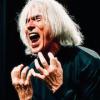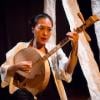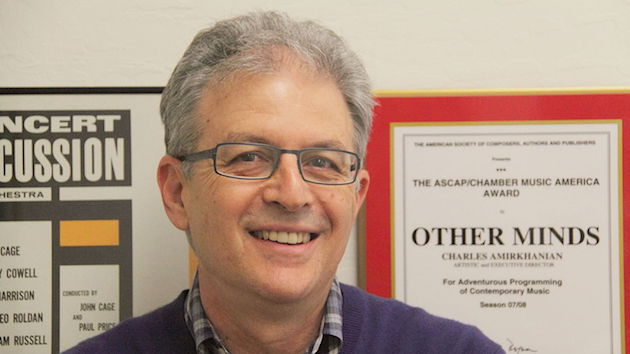
Last year’s release of Loudspeakers by New World Records is the latest in four decades of forward-thinking recordings by the Bay Area’s Charles Amirkhanian. Its fanciful engagement extends from the collage cover art — created by Carol Law, the composer’s wife — through the first of two discs, a series titled “Pianola” and based on the sound and techniques of the player piano, through the second disc’s Son of Metropolis — a paean to Northern California incorporating birdsong from Aptos, the barking of seals, and conversations in Chinese and Tongan — and the title composition, an homage to Morton Feldman deploying the acoustics of a 1984 interview with that composer. “What links all these pieces,” comments former Village Voice critic Kyle Gann, “is a creative ambiguity of genre [involving] a delight in shifting back and forth between elements whose sources can be recognized and those whose can’t.”
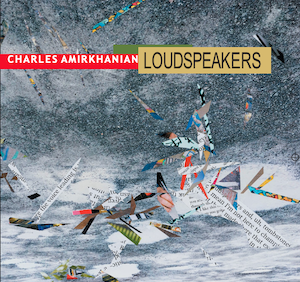 That description might apply also to Amirkhanian’s Other Minds, the self-described “global new-music community” which, since 1993, has commissioned works and staged concerts and annual festivals and has produced recordings and radio broadcasts. Amirkhanian’s composition began in his hometown of Fresno, California, where he was raised by Armenian-American parents. His mother Eleanor was a musician and his father Benjamin a writing teacher who founded the William Saroyan Society.
That description might apply also to Amirkhanian’s Other Minds, the self-described “global new-music community” which, since 1993, has commissioned works and staged concerts and annual festivals and has produced recordings and radio broadcasts. Amirkhanian’s composition began in his hometown of Fresno, California, where he was raised by Armenian-American parents. His mother Eleanor was a musician and his father Benjamin a writing teacher who founded the William Saroyan Society.
A few years after graduating in English from Fresno State College, Charles came to the Bay Area where he became music director of Berkeley’s listener-supported KPFA-FM and obtained graduate degrees at San Francisco State College and Mills College. Now 75, Amirkhanian has co-directed Telluride Institute’s Composer-to-Composer festival and has been honored by the American Music Center, ASCAP, and Chamber Music America for adventurous programming. He spoke with SFCV about his background, how he’s kept busy during COVID sheltering, the evolution of new music, and what’s not likely to be a reclusive retirement.
How does such a nimble mind stay active during shutdown, Charles?
Spending a lot of time in Zoom meetings. The Other Minds staff members are working mostly from home, but sometimes one of us will go to the office [on San Francisco’s Mason Street] and collect the mail, and record our radio program. KALW [91.7 FM] increased our time from one hour to two [Friday, 10 p.m. to Midnight], which has allowed us to do the first full recording of The Cradle Will Rock [by Marc Blitzstein]. And we’ve been noticing an enormous increase in the audience.
I still see online an announcement for a concert Other Minds had scheduled for last week, at the Center for New Music.
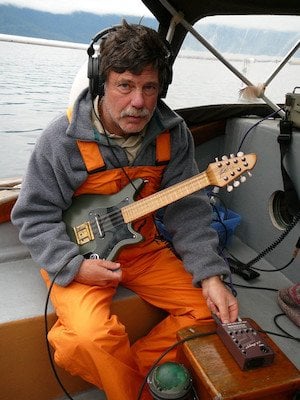
We didn’t do it, but we’re getting ready to do something big. We’ve been doing this thing called The Nature of Music, where composers who use ambient sound hold forth. Jim Nollman lives in the state of Washington, on an island, and he’s known for performing on saxophone or flute with turkeys, orca whales, and various other species. He came around to KPFA in the mid-’70s [where Amirkhanian worked from 1969 to 1992], and asked if I’d let him go to this place in Petaluma where they raise turkeys. He recorded this piece called Turkey Songs, and I played it on the air at Thanksgiving, and it became a hit; NPR picked it up. Jim will be doing a streaming event from his home, with me interviewing him, on Dec. 3. We have a series of concerts called Latitudes which we’ve been doing at the Center for New Music, we’re thinking of doing it outdoors, and we’ll do our first one next year in an airplane hangar at Mare Island. But we’re not going to take the Other Minds 25 [festival] and try to put that on streaming; we’re holding out till we can actually do it in a concert hall.
It should be obvious, but why not on Zoom?
The interaction between free improvisers is chilled if they’re not in the same acoustic space. The overtones don’t interact with each other, the musicians can’t see each other. And just the fact that so many people are scrambling to stream makes me not want to do it. It’s too desperate.
What other unique things have you been up to while sheltering?
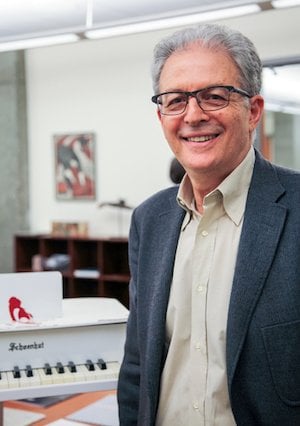
If it hadn’t been for this music librarian back in Fresno, Ronald Harlan, who had essentially had the biggest collection of modern music of any state university in the system, I wouldn’t be the person I am today. He introduced me to the music of Lou Harrison and John Cage and various other people. In the 1950s, there’d been an explosion of small record labels, and one thing I’ve been doing during the pandemic is, I’ve been going online and finding LPs I’d learned about from Ron. And they’re for sale, for five dollars! Because all of the people who collected them are croaking. [Laughs] I also just found this file with correspondence from the faculty [of Fresno State College], who’d been leery of me, because I kept presenting weird music, but praising me for putting them on the map.
How did that happen?
I was an English major, but I was also president of the music fraternity, Phi Mu Alpha Sinfonia. I also helped start the percussion ensemble.
Did you start out on drums?
I’d taken piano lessons from one of my mother’s sisters, Lorraine. Their surname was “Kaprielian,” and the three sisters all went to Fresno State and majored in music. Lorraine would assign me Czerny etudes and things like that, but I kept gravitating towards [Dimitri] Kabalevsky and Bartók; when it came to more modern harmonies, I was just drawn to that. In the fifth grade, I became a drummer in the elementary school orchestra, and from then on, I noticed that anything you could strike could be an instrument, and naturally that put me in the sphere of more experimental music. I saw that Lou and John [Harrison and Cage] sent out to junkyards and got brake drums, so I got license plates and Venetian blinds and anything else I could make a clatter with.
And you ended up getting the green light from the Fresno State faculty.
I was sent to the national convention [of Phi Mu Alpha Sinfonia] in St. Louis in 1964, and had the mind-blowing experience of playing the bass drum under Frederick Fennell in the convention band. I wrote drum cadences for the high school and college bands, and we gave the first performance in Fresno of Morton Feldman’s Piece for Four Pianos, one of his most beautiful.
I wrote to Leslie Bassett, who went to Fresno State and won the Pulitzer Prize in 1966, and I said, “We’d like to play some of your music, could you come out here [from Michigan] for the concert?” I got all the faculty members together to play his difficult chamber music, and the new president of Fresno State, who played the clarinet. Also, I saw a big gap in the senior recitals, which were all Beethoven and Schubert, and I noticed that all these faculty members didn’t play their own music, so I organized a whole bunch of concerts.

No wonder they liked you. Did you ever like the rock ’n’ roll you and I grew up alongside of?
I avoided it when I was writing. But the rhythm of snare drum playing had a lot do to with my sound poetry.
When did that become an expression for you? Did you have role models?
In 1965, when I was 20. There had been Ernst Toch’s Geographical Fugue; “Sparky’s Song,” which was a bunch of tongue-twisters repeated over and over, from Big John and Sparky [a radio show]; and Virgil Thomson’s Capitals, Capitals,” which used Gertrude Stein’s absurdist text in rhythms that were really beautiful.
When did you get to San Francisco?
In 1967, after I got my bachelor’s [at Fresno State] and then a master’s at San Francisco State in 1969, in Interdisciplinary Creative Arts. I did a whole thesis about how to play a picture as a performance, in any medium. It was related to my interest in [the multidisciplinary movement] Fluxus, which was emerging in New York.
Where were things happening for new music back then?
I was living at 732 Ashbury; I was a neighbor of the Grateful Dead. But the principal address would have been 321 Divisadero Street, where there was Anna Halprin’s Dancers Workshop Company and the San Francisco Tape Music Center. The building had a huge upstairs ballroom that was fitted out for electronic music performance and live radio broadcast by KPFA. Growing up in Fresno, I’d listened to those broadcasts late at night — Pauline Oliveros, Morton Subotnick, Ramon Sender, and Terry Riley, the avant-garde who studied with Robert Erickson [at San Francisco State, UC Berkeley, and the San Francisco Conservatory]. I became Anna’s music director for a couple of years, and whenever she needed something, I would write music for it.
How were you getting by?
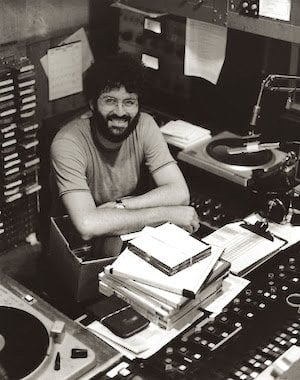
I was working at the Sea of Records store, where I’d meet all these musicians. It was there that [critic] John Rockwell and [bassoonist] Bob Hughes came in and told me about this job opening at KPFA. Howard Hersh, the station’s previous music director, had gotten a job at the Conservatory doing fabulous concerts at the De Young Museum. Maybe you attended one of them.
I saw John Cage there, with his radios [Imaginary Landscapes].
I was getting peanuts [at KPFA], it barely exceeded what I was getting paid at the record store. But somehow things kept happening. I got to go to Sweden for a month to do sound poetry for the Swedish radio, and Carol and I stayed for another six weeks and drove all around Europe and interviewed sound poets. I brought them back and played them on the air, and suddenly I noticed that people were paying more attention to me, going beyond the Bay Area.
In 1979, the New Music America Festival started, and also I was on the board of the American Music Center in New York. I met everyone I could from the Downtown music scene and recorded interviews and brought them back and played them. Carol and I started producing concerts where she would take closeups of little objects and project them on a big screen, and I would stand in front of the screen and recite my sound poetry.
What evolved with the new-music scene in the Bay Area during your stint at KPFA? I recall hearing Steve Reich premieres on your show, and also the concerts at and recordings from 1750 Arch Records, in Berkeley.
That was started by Tom Buckner, whose grandfather was Thomas Watson, who founded IBM. We broadcasted his concerts every Friday night. Then I came to him with three pages of ideas, and he pointed to Conlon Nancarrow’s Complete Studies for Player Piano. He sent me and his engineer, Robert Shumaker, to Mexico City, and we recorded all of Conlon’s player piano rolls and released them on four LP’s, one record at a time. What Conlon wanted was to be able to play five [beats] against 13 against nine, and you could only do that if you’re a robot or a player piano roll.
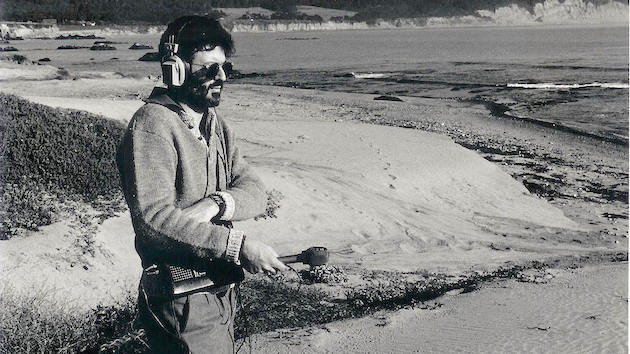
John Adams’s recruitment in 1979 as New Music Adviser to the Francisco Symphony was a boon.
It kind of legitimized the experimental music of the day. John would play Boulez and Babbitt, but he’d also present Steve Reich and Terry Riley, and that was really more fun. Then, in 1984, the CD started being issued, and the blessing of that was mitigated by the fact that everybody could steal everything. Coming up to the current scene, where you have a democratization which is almost like New Music Facebook. Everybody can have a say, everybody can release their stuff on Bandcamp, and then you have to figure out which things you like. And I think that’s where Other Minds comes in.
Has there been a particular contribution from the West Coast to contemporary music?
The fact that John Cage was born in Los Angeles, Henry Cowell in Menlo Park, Lou Harrison in Oregon, these people, even in the early ’50s, were outsiders. When they went to New York and found out they were outsiders, Lou went crazy, and John lived as a pauper for years and years. And every now and then someone like [pianist] Maro Ajemian or [producer] George Avakian would come along and give these guys a break.
Is there some special connection between Armenians and new music? Of course, Alan Hovhaness, a composer, was also Armenian.
Some of these people were acquainted with Armenian Orthodox church music, which is Middle Eastern-modal and very melodic. By contrast, Bernstein and Copland were dismissive of Hohvaness’s music, and one of them even called it “ghetto music.” But when you listen to his best works, they’re just surpassingly beautiful!
Are you composing?
I haven’t, for two years, but I’m working on a piece for a festival in London, for eight percussionists and player piano. I’ll work with Rex Larson, the player piano virtuoso, and the percussionist Dominic Murcott, who’s a Nancarrow specialist. They’re suggesting a concert date of June of 2021, but they’re not so sure.
You don’t look or act or sound like a guy contemplating retirement.
But because I’m superannuated, I have to figure out what the future of Other Minds is. I haven’t told anybody yet, but we’re launching a planned giving campaign that will have people leaving money in their wills for Other Minds, so that we can carry on this enormous archive we’ve created and add to it as years go by. We’re going to use part of the interest of that to pay part of our expenses.
It seems as we baby boomers approach our shelf-life date, this becomes more urgent.
And the nice thing, between you and me, is that there are a whole bunch of people in their 20s, 30s, and 40s who think that everything that happened in the 1970s was very cool!


